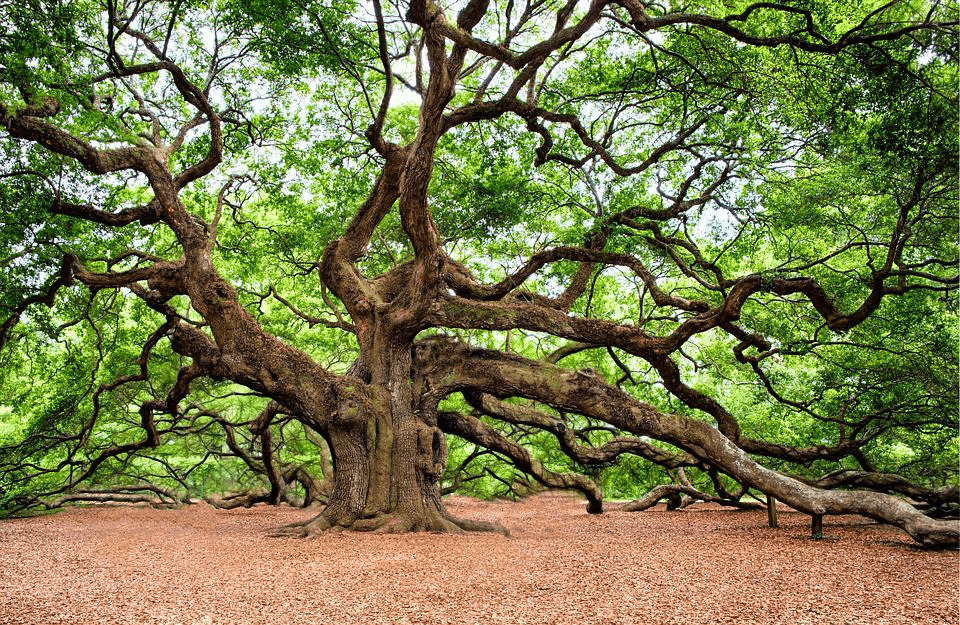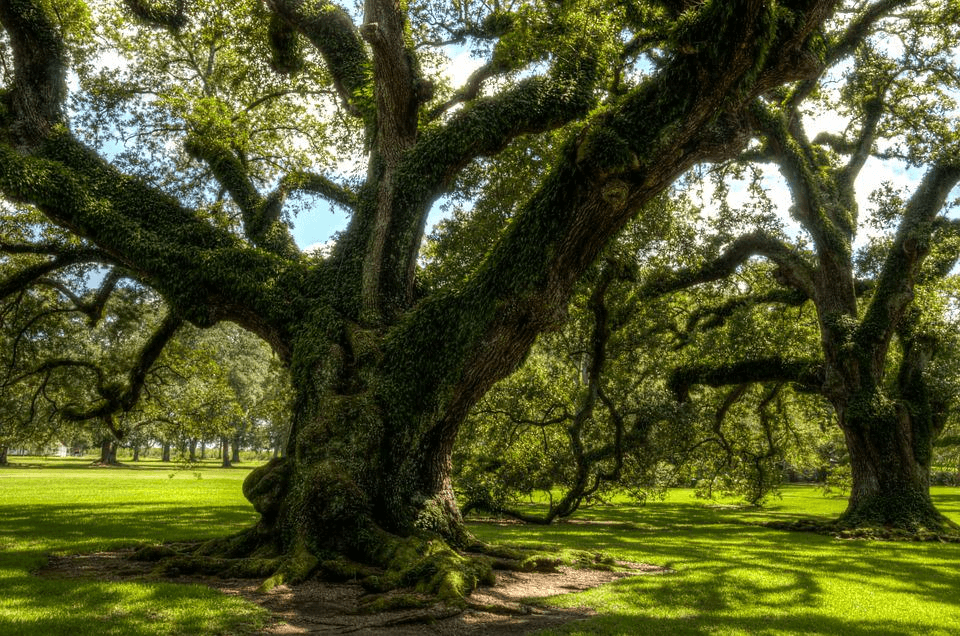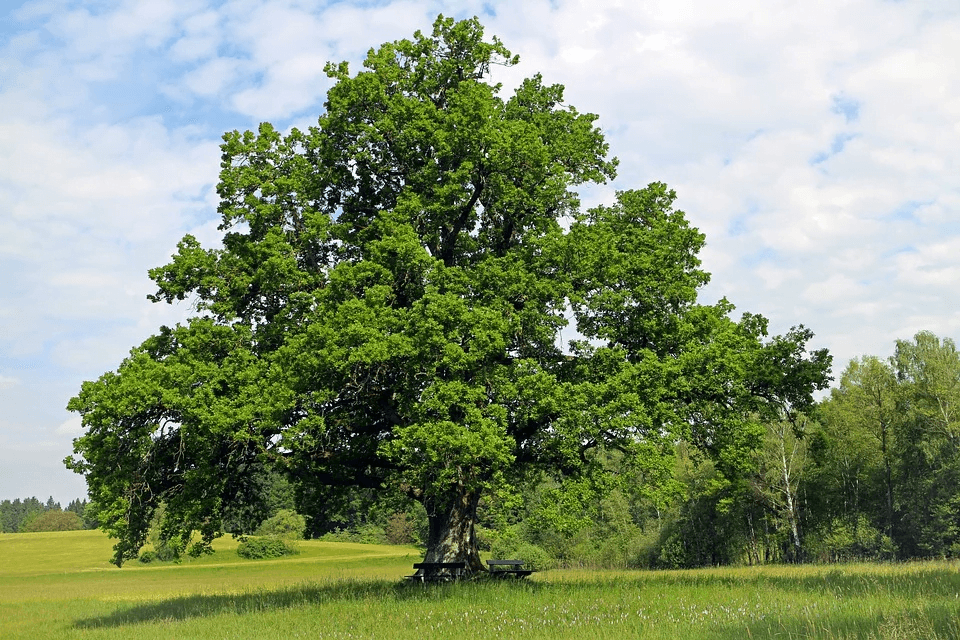There are about 500 identified oak species. They vary in size, appearance, as well as their lifespans.
Under ideal conditions, the average lifespan of oak is about 100 – 300 years, some more, some less. Individual lifespans depend on environmental conditions, pests, diseases, and commercial development, among other factors.
Short-lived varieties die after about 50 to 60 years. The water oak native to the southeastern United States lives for only 30 to 50 years and the laurel oak, also native to the Southeast, lives for 50 to 60 years.
Among the very long-lived specimens known are the Middleton Oak and the Angel Oak, both in South Carolina. The Angel Oak is around 400 to 500 years old.

Many oak trees live longer than 100 years. The American Forest, a conservation organization, has estimated the age of one southern live oak (Quercus virginiana) in Louisiana to be 1,500 years old.
Although most oak trees rarely live up to this age, other long-lived oak trees aside from the southern live oak include holly oak (Quercus ilex) found in hardiness zones 7 through 10; canyon live oak (Quercus chrysolepis) found in USDA zones 8 through 10 and valley oak (Quercus lobata) that exists in USDA zones 7 through 9.
Western live oaks
Lifespan: More than 150 years
Live oaks, also known as evergreen oaks have heights of about 65 feet and crown spreads of more than 70 feet. They include coast live oak (Quercus agrifolia), hardy in U.S. Department of Agriculture plant hardiness zones 9 and 10; and interior live oak (Quercus wislizeni) and canyon live oak (Quercus chrysolepis), both hardy in USDA zones 8 through 10.
The age of Coast Live oaks at Stanford University was estimated to be around 300 years old. A huge coastal live oak on the Pechanga Indian Reservation in California is estimated to be 850 to 1,500 years old.
Southern live oak (Quercus virginiana)
This is another long-living oak tree growing up to 60 to 80 feet tall and 60 to 120 feet wide. Southern live oak is hardy in USDA zones 7b through 10b.
To properly maintain the Southern Live Oak, it’s important to shape the tree during its early years. Also, you should prune it each year for the first three years after planting and then every five years to age 30. This helps to establish a strong scaffold and suitable structure for its expected life of 200 to 300 years.
A number of oaks that are similar to Southern live are distributed throughout the South. Examples are the Middleton Oak and the Angel Oak, both in South Carolina. The Angel Oak is thought to be 400 to 500 years old.
Valley oak (Quercus lobata)
Lifespan: About 1,000 years
Valley Oak is native to the central and interior valleys of California. It is one of the tallest-growing deciduous oaks. One of the samples of Valley oak seen grows up to about 153 feet high with a crown spread of 99 feet. The estimated age for these tall trees is about 1,000 years. Valley oak grows in USDA zones 7 through 9.
Pin oak (Quercus palustris)
Lifespan: 150 years
The pin oak is also known as the swamp Spanish oak. It is a species of red oak. The Pin Oak gets its name from the short branchlets that grow along the greater branches and limbs. It is a water-tolerant oak species and it is sometimes classified as a water oak.
Unlike the Water Oak, Pin Oak is more commonly found in more northern, interior states and all the way up to Ontario, Canada.
Pin oaks grow primarily on poorly drained floodplain and river-bottom soils. Generally, pin oaks grow well near high clay content as well. Pin oak is one of the most commonly used landscaping oaks in its native growth zone because it is easy to transplant, grows very quickly, and is tolerant of pollution.
Blue oak (Quercus douglasii)
Lifespan: Above 400 years
It grows in USDA zones 5 through 10 and can also grow more than 100 feet in height as seen with a 112-feet-high tree in Three Rivers, California.
Black oak (Quercus velutina)
Lifespan: 100 years
Black Oaks are native and widespread throughout eastern and central North America. It can be commonly seen in areas like Maine, Texas, Michigan, Ontario, Minnesota, Nebraska, Kansas, and Oklahoma. Black oaks grow best on well-drained, silty clay. It is generally considered a slow grower, with an average growth rate of 8-12 inches until its roots are established. However, once it is settled in, these trees can grow two to three feet a year under optimum growth conditions.
Bur oak (Quercus macrocarpa)
Lifespan: 200-300 years
Bur Oak is an Oak with large fruit. It can grow to over 80 feet in height, has leaves that are over 10 inches long, and produces acorns bigger than limes!
Bur Oak, also called the Mossycup Oak, gets its name from the shaggy acorn cap that tops its acorns. Once sprouted, these trees have a moderate growth rate and can grow more than 20 inches each year.
Bur oaks are often found in open woods, and stream edges, preferably closer to the water. One of the oldest Bur Oaks, the Bicentennial Tree, is believed to be more than 400 years old. Their average lifespan is around 200-300 years.

Short-lived oak varieties
Short-lived oak trees are those that live for about 30 to 50 years. For oak trees, 50 years counts as short-lived. A native of the southeastern United States, laurel oak (Quercus laurifolia) lives 50 to 60 years and grows to about 65 feet tall.
Also native to the Southeast, water oak (Quercus nigra) reaches 60 to 80 feet tall and lives 30 to 50 years. Laurel oak and water oak are hardy in USDA zones 6 through 10.
Laurel oak (Quercus laurifolia)
Lifespan: 50-70 years
The Laurel Oak is a fast-growing oak that can reach over 100 feet tall. It is a relatively short-lived species when compared to many other Oak species, often dying off after about 60 years.
It is a good oak for more humid and rain-heavy climates but can adapt to virtually all temperature conditions. It can be found in the coastal region south of New York and grows on the west coast up through Washington state. It grows well from Florida to Southern California, and also in Mexico.
Water oak (Quercus nigra)
Lifespan: 60-80 years
The water oak is native to the eastern and south-central United States. You can find it in all the coastal states from New Jersey to Texas, and inland as far as Oklahoma, Kentucky, and southern Missouri.
Compared to some other Oaks, the water oak is selective to environmental conditions. As a wetland tree, it occurs naturally in lowlands and up to 1500 ft in altitude. It is adapted to wet, swampy areas and can tolerate well-draining soil. It grows well in sandy soils or red clays.
Water oak does not do well on crowded plots and does not tolerate shade. It is relatively short-lived, making it 60-80 years on average. However, it is a fast grower and reproduces quickly, making it an excellent candidate for restoring bottomland hardwood forests after agriculture or pine plantation usage.
Factors that increase lifespan of oak trees
- The first and most crucial factor is to plant an oak tree variety that thrives in your USDA zone. This is the first step in ensuring that the tree lives a long and healthy life.
- All oak species grow best in places with full-sun exposure, although different varieties have different watering needs.
- Oaks from dry-summer areas, such as valley oak, need no watering during winter after they’ve been established in their location for about six or seven years. Species native to wet climates, such as water oak, require watering during winter.
- Oak trees are vulnerable to root pathogens, so it’s essential to take care not to disturb the tree’s root protection zone. If you’re remodeling or installing pipelines, ensure that the root area is not compromised by trenching or excavation activities. Also, avoid soil compaction or paving that will affect soil drainage.
- When planting a new oak tree, make sure it has well-draining soil that is deep enough for the long taproot and subsequent lateral roots, which often extend 90 feet beyond a mature tree’s dripline. Check the mature size of your tree so you can give it enough room to grow.

Maintenance of oak tree
- Oak trees (except Pin Oak or Water Oak) prefer full sun and well-drained soil.
- Oaks can handle a good soaking in winter if you are having a dry season. It is also recommended that you water them during a dry summer.
- You should water them moderately to avoid overlogging.
- Oak trees are shade providers but they do not require it for themselves. Full sun is the way to go to make sure that your oak grows up happy and healthy, ensure they are exposed to full sun.



